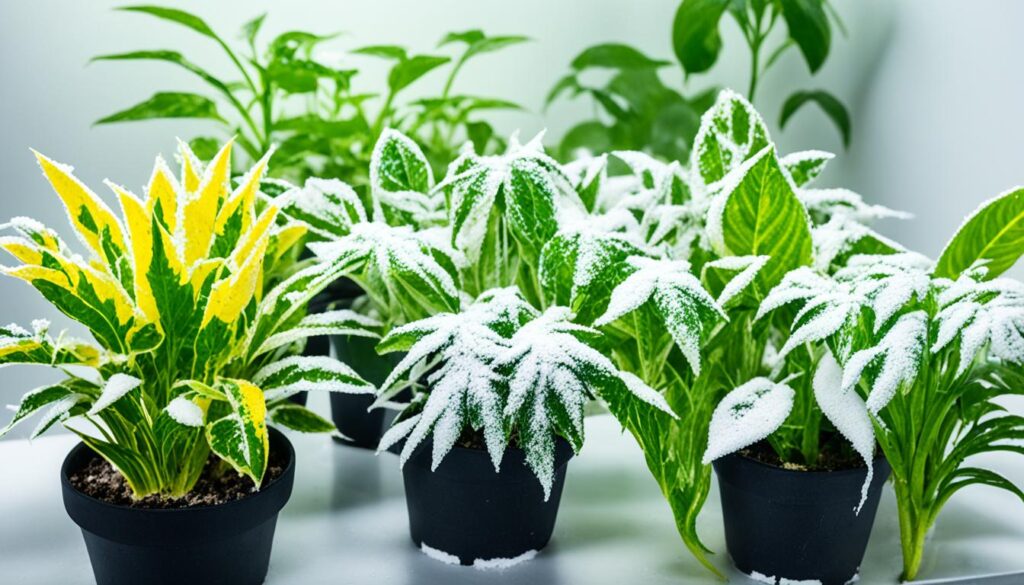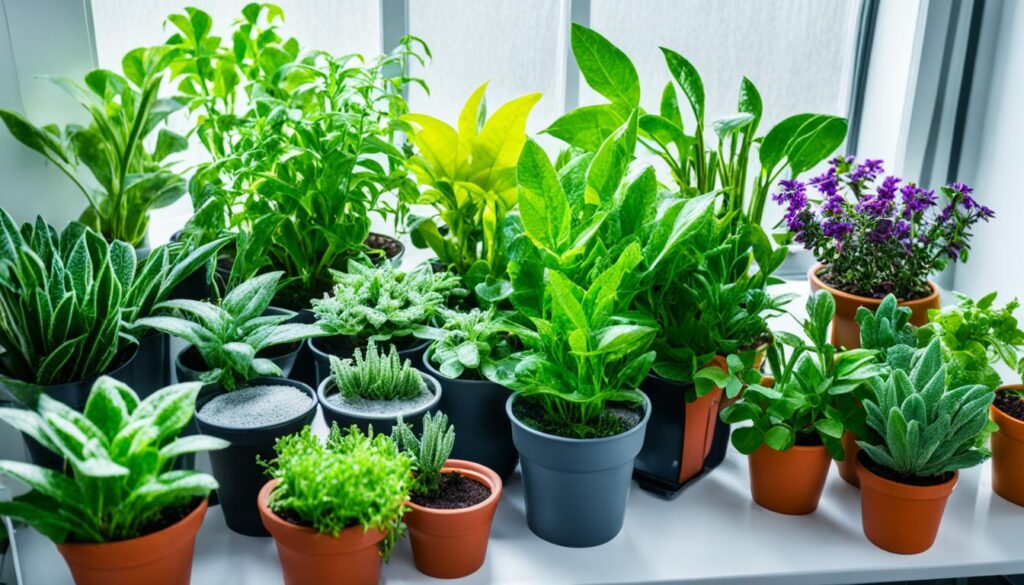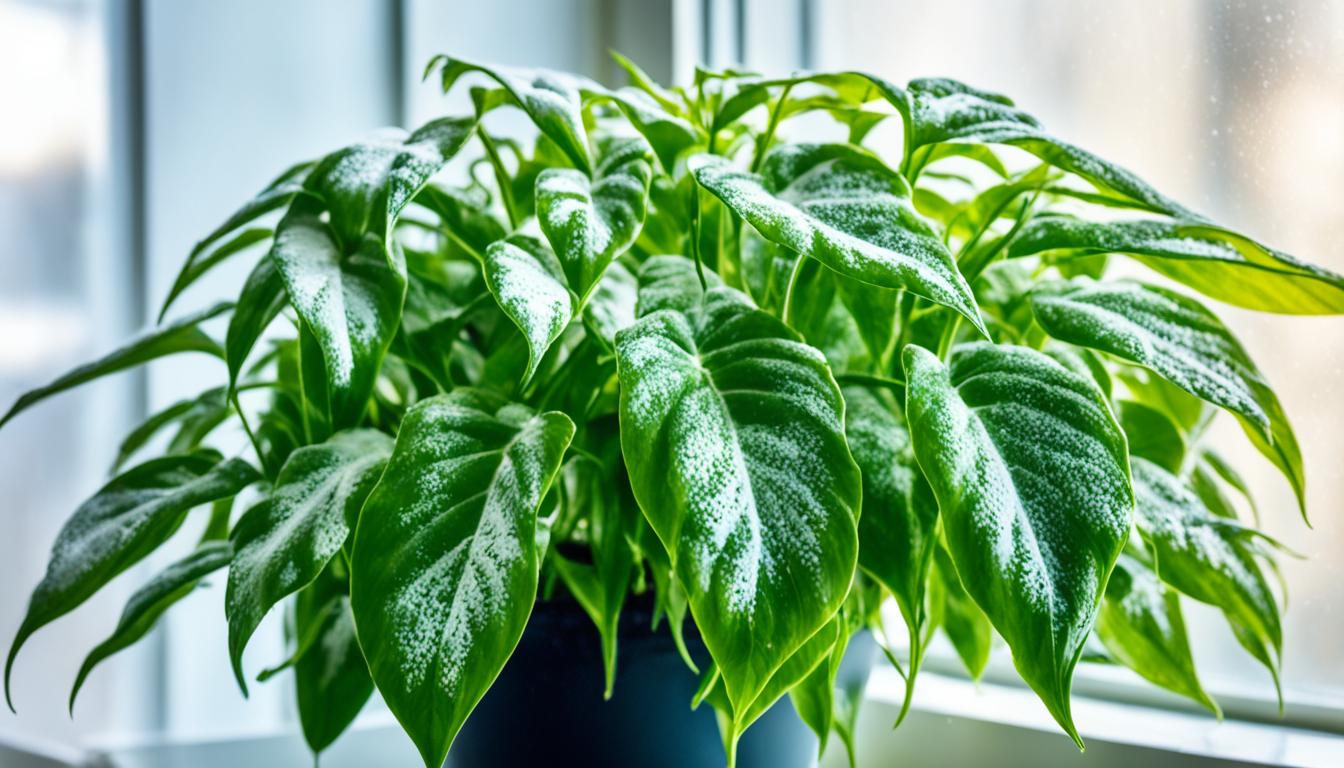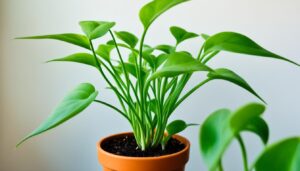Have you ever seen a white, powdery stuff on your houseplants? This is powdery mildew, a common fungal disease. It can harm your plants if you don’t act fast. But don’t worry, you can fight this problem and keep your plants healthy.
Imagine your indoor plants looking vibrant and lush again. We’re going to talk about powdery mildew, which plants get it, and how to stop and treat it. Get ready to make your indoor space beautiful and powdery mildew-free!
What is Powdery Mildew and How Does it Affect Indoor Plants?
Powdery mildew is a common fungal disease that can harm your indoor plants. It’s caused by various fungi and can spread fast. Soon, it covers large parts of your plant, making it look powdery, white, or silvery.
Symptoms and Diagnosis
The main sign of powdery mildew is powdery white spots on leaves, stems, and flowers. These spots can grow together, covering the whole plant. In bad cases, leaves may become misshapen, change color, or fall off early.
Spotting the symptoms and figuring out the disease is key. Look closely at your plants for the powdery mildew signs. This helps you act fast to stop it from getting worse.
| Powdery Mildew Symptoms | Potential Impact on Indoor Plants |
|---|---|
|
|
By keeping an eye out and acting quickly, you can protect your indoor plants. Knowing about this fungal disease and its effects is the first step in caring for your plants. It helps with controlling houseplant fungus.
“Powdery mildew can be a frustrating and persistent problem for indoor plant enthusiasts, but with the right knowledge and proactive approach, it can be effectively managed.”
Common Indoor Plants Susceptible to powdery mildew indoor plants
Not every plant can avoid powdery mildew, a common fungal disease. Some indoor plants are more likely to get it. These include begonias, sunflowers, chrysanthemums, dahlias, roses, and zinnias. Also, fruits and vegetables like melons, zucchini, squash, lettuce, cucumbers, potatoes, parsley, pumpkins, grapes, peppers, tomatoes, and tree fruits can get powdery mildew.
It’s important to watch over mildew resistant indoor plants closely. Taking steps early can stop powdery mildew on indoor plants from spreading. By acting fast when you see disease signs, you can keep your plants healthy and thriving.
| Indoor Plants Susceptible to Powdery Mildew | Fruits and Vegetables Susceptible to Powdery Mildew |
|---|---|
|
|
Knowing which plants are at risk helps you act early. This can stop powdery mildew on indoor plants from spreading. Keeping your indoor garden healthy and full of life is easier with the right steps.
Preventative Measures to Stop Powdery Mildew Indoors
Keeping your indoor plants healthy is the best way to stop powdery mildew. By keeping the right growing conditions, you make your plants less likely to get this fungal disease. Here are some important steps to take:
Improving Growing Conditions
Good air flow is key to stopping powdery mildew on your indoor plants. Make sure there’s enough space between your plants for air to move around. Don’t pack your plants too close together, as this can trap moisture and help the indoor gardening mildew remedies grow.
- Give your plants enough light, as powdery mildew likes dark, damp places.
- Use soil that drains well and don’t overwater to avoid too much moisture.
- Don’t overfeed your plants with high-nitrogen fertilizers, as this can make them more prone to the fungus.
- Trim off any dead or sick leaves to stop the infection from spreading.
By keeping these conditions right, you can prevent powdery mildew indoor plants before it starts. This saves you time and effort later on.
“The key to preventing powdery mildew is creating an unfavorable environment for the fungus to thrive.”

Treatment Methods for Powdery Mildew on Houseplants
If you can’t stop powdery mildew from spreading on your indoor plants, there are ways to treat it. You can use organic or chemical methods. It’s important to act fast and effectively to stop the fungal infection from getting worse.
Organic Remedies for Powdery Mildew
For a natural way to fight powdery mildew on indoor plants, try these organic methods:
- Baking soda and soap solution: Mix 1 teaspoon of baking soda and a few drops of mild liquid soap in a spray bottle with water. Spray the plants, especially the underside of leaves.
- Milk spray: Mix some milk (cow, goat, or plant-based) with water in a spray bottle. Spray it on the plants. The proteins in milk can stop powdery mildew from growing.
- Mouthwash: Some mouthwashes have ingredients that can kill powdery mildew plant fungus. Mix a little with water and spray it on the plants.
These organic remedies for powdery mildew can kill the fungal spores and stop the disease from spreading.
Chemical Fungicide Treatments
For serious cases of powdery mildew treatment indoors, you might need to use chemical fungicides. Look for products with neem oil, which fights fungi and insects. Always follow the instructions and apply these treatments outside to keep your indoor air clean.
Using both prevention and targeted treatments can help your indoor plants stay healthy and look great.

Conclusion
Keeping powdery mildew indoors and preventing mildew on houseplants is crucial for your plants’ health and beauty. Learn the signs, know which plants are at risk, and take steps to improve their environment. This way, you can fight off this common fungal disease.
If you see powdery mildew, try both natural and chemical treatments to get rid of the fungus. This will help stop it from spreading further. With careful attention and the right methods, your indoor plants can stay healthy and look great.
Being well-informed and proactive is the key to handling powdery mildew in your indoor garden. By using these tips, you can keep your plants strong, colorful, and ready to face any challenges.
FAQ
What is powdery mildew and how does it affect indoor plants?
Powdery mildew is a common fungal disease that affects many indoor plants. It looks like a dusty, white to gray coating on leaves, stems, buds, or flowers. This disease can hurt photosynthesis, slow plant growth, and make plants look bad if not treated.
What are the symptoms of powdery mildew on indoor plants?
Powdery mildew shows up as circular, powdery white spots on leaves. These spots can spread to cover the whole plant. Knowing the symptoms is the first step to fix the problem.
Which indoor plants are most susceptible to powdery mildew?
Some indoor plants are more likely to get powdery mildew. These include begonias, sunflowers, chrysanthemums, dahlias, roses, and zinnias. Fruits and vegetables like melons, zucchini, squash, lettuce, cucumbers, potatoes, parsley, pumpkins, grapes, peppers, tomatoes, and tree fruits can also get it.
How can I prevent the development of powdery mildew on my indoor plants?
To stop powdery mildew, keep your plants in good conditions. Make sure they have enough air, don’t over-fertilize, and put them in bright spots. Good drainage and compost can also help. Remove dead or sick leaves and stems to stop the disease from spreading.
What treatment options are available for powdery mildew on indoor plants?
If you can’t prevent powdery mildew, there are ways to treat it. You can use a baking soda and soap mix, milk spray, or mouthwash. For worse cases, you might need to use approved organic fungicides. Neem oil is also a fungicide option.




